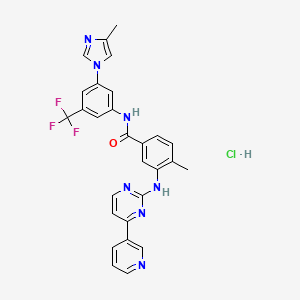
Nilotinib hydrochloride
Cat. No. B1258797
M. Wt: 566.0 g/mol
InChI Key: VTGGYCCJUPYZSX-UHFFFAOYSA-N
Attention: For research use only. Not for human or veterinary use.
Patent
US08829015B2
Procedure details


12 g 4-methyl-N-[3-(4-methyl-imidazol-1-yl)-5-trifluoromethyl-phenyl]-3-(4-pyridin-3-yl-pyrimidin-2-ylamino)-benzamide hydrochloride is dissolved in 192 mL of methanol and 21 ml of water at 52° C. The solution is heated to 64-66° C. in 10 minutes and let stand for 45 minutes. The solution is then cooled down in 3 hours at 0° C. The solution spontaneously crystallized before 0° C.; therefore, the cooling ramp was stopped at 20° C. and let stand with stirring for 2 days. The suspension is cooled down to 0° C. in 2 hours before filtration under vacuum to obtain form A of the hydrochloride salt of 4-methyl-N-[3-(4-methyl-imidazol-1-yl)-5-trifluoromethyl-phenyl]-3-(4-pyridin-3-yl-pyrimidin-2-ylamino)-benzamide.
Quantity
12 g
Type
reactant
Reaction Step One



Identifiers


|
REACTION_CXSMILES
|
Cl.[CH3:2][C:3]1[CH:27]=[CH:26][C:6]([C:7]([NH:9][C:10]2[CH:15]=[C:14]([C:16]([F:19])([F:18])[F:17])[CH:13]=[C:12]([N:20]3[CH:24]=[C:23]([CH3:25])[N:22]=[CH:21]3)[CH:11]=2)=[O:8])=[CH:5][C:4]=1[NH:28][C:29]1[N:34]=[C:33]([C:35]2[CH:36]=[N:37][CH:38]=[CH:39][CH:40]=2)[CH:32]=[CH:31][N:30]=1.O>CO>[CH3:2][C:3]1[CH:27]=[CH:26][C:6]([C:7]([NH:9][C:10]2[CH:15]=[C:14]([C:16]([F:17])([F:18])[F:19])[CH:13]=[C:12]([N:20]3[CH:24]=[C:23]([CH3:25])[N:22]=[CH:21]3)[CH:11]=2)=[O:8])=[CH:5][C:4]=1[NH:28][C:29]1[N:34]=[C:33]([C:35]2[CH:36]=[N:37][CH:38]=[CH:39][CH:40]=2)[CH:32]=[CH:31][N:30]=1 |f:0.1|
|
Inputs


Step One
|
Name
|
|
|
Quantity
|
12 g
|
|
Type
|
reactant
|
|
Smiles
|
Cl.CC1=C(C=C(C(=O)NC2=CC(=CC(=C2)C(F)(F)F)N2C=NC(=C2)C)C=C1)NC1=NC=CC(=N1)C=1C=NC=CC1
|
|
Name
|
|
|
Quantity
|
192 mL
|
|
Type
|
solvent
|
|
Smiles
|
CO
|
Step Two
|
Name
|
|
|
Quantity
|
21 mL
|
|
Type
|
reactant
|
|
Smiles
|
O
|
Conditions


Temperature
|
Control Type
|
UNSPECIFIED
|
|
Setpoint
|
65 (± 1) °C
|
Stirring
|
Type
|
CUSTOM
|
|
Details
|
with stirring for 2 days
|
|
Rate
|
UNSPECIFIED
|
|
RPM
|
0
|
Other
|
Conditions are dynamic
|
1
|
|
Details
|
See reaction.notes.procedure_details.
|
Workups


CUSTOM
|
Type
|
CUSTOM
|
|
Details
|
at 52° C
|
TEMPERATURE
|
Type
|
TEMPERATURE
|
|
Details
|
The solution is then cooled down in 3 hours at 0° C
|
|
Duration
|
3 h
|
CUSTOM
|
Type
|
CUSTOM
|
|
Details
|
The solution spontaneously crystallized before 0° C.
|
CUSTOM
|
Type
|
CUSTOM
|
|
Details
|
was stopped at 20° C.
|
TEMPERATURE
|
Type
|
TEMPERATURE
|
|
Details
|
The suspension is cooled down to 0° C. in 2 hours before filtration under vacuum
|
|
Duration
|
2 h
|
Outcomes


Product
Details
Reaction Time |
45 min |
|
Name
|
|
|
Type
|
product
|
|
Smiles
|
|
|
Name
|
|
|
Type
|
product
|
|
Smiles
|
CC1=C(C=C(C(=O)NC2=CC(=CC(=C2)C(F)(F)F)N2C=NC(=C2)C)C=C1)NC1=NC=CC(=N1)C=1C=NC=CC1
|
Source


|
Source
|
Open Reaction Database (ORD) |
|
Description
|
The Open Reaction Database (ORD) is an open-access schema and infrastructure for structuring and sharing organic reaction data, including a centralized data repository. The ORD schema supports conventional and emerging technologies, from benchtop reactions to automated high-throughput experiments and flow chemistry. Our vision is that a consistent data representation and infrastructure to support data sharing will enable downstream applications that will greatly improve the state of the art with respect to computer-aided synthesis planning, reaction prediction, and other predictive chemistry tasks. |
